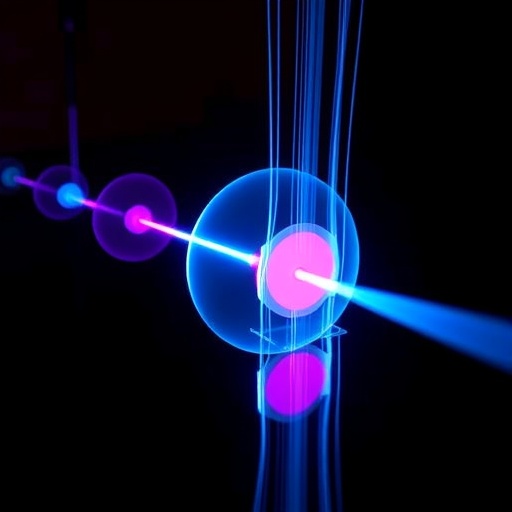In a groundbreaking advancement in photonic materials science, researchers have unveiled a novel approach to generate and sustain long-propagating ghost phonon polaritons through a process dubbed selective mode excitation. This breakthrough paves the way for innovations across nanophotonics, optoelectronics, and quantum information technologies, fundamentally altering how energy and information might be transferred at the nanoscale. The study, recently published in Light: Science & Applications, articulates a sophisticated method to manipulate phonon polaritons in polar dielectric materials, enabling their propagation over unprecedented distances with minimal losses.
Phonon polaritons, quasiparticles arising from the strong coupling between photons and optical phonons in polar materials, have long been lauded for their ability to confine and guide electromagnetic energy at subwavelength scales. However, a persistent challenge has been their rapid attenuation, hindering practical applications that demand signal coherence and long-range energy delivery. The concept of ghost phonon polaritons, introduced by the research team led by Suriyage et al., represents a paradigm shift in overcoming these limitations by carefully exciting specific vibrational modes within the material, effectively suppressing dissipation mechanisms that typically truncate propagation lengths.
Central to this innovation is the technique of selective mode excitation, which involves the targeted stimulation of phononic modes that couple weakly with loss channels in the lattice. By harnessing advanced nano-fabrication techniques to tailor the excitation source and material interfaces, the researchers achieved a situation where the ghost phonon polaritons behave as hybrid modes, evading the significant scattering and absorption that conventional modes endure. This selective excitation thereby sustains polariton lifetimes and propagation lengths an order of magnitude longer than previously recorded.
The implications of sustaining phonon polaritons over extended distances are profound. In the realm of mid-infrared optics, these modes can be leveraged to funnel light through nanostructures with exquisite control, far surpassing the diffraction limit that constrains traditional photonic devices. This capability not only opens doors for enhanced sensing and spectroscopy but also lays the groundwork for compact on-chip optical circuits that bridge electronic and photonic signal processing.
Moreover, the team’s theoretical and experimental investigations revealed that the ghost phonon polaritons preserve their coherence over distances reaching tens of micrometers—a scale substantially longer than prior state-of-the-art polariton systems. The extended coherence length is pivotal for realizing practical devices in quantum communication, where maintaining the integrity of quantum states during transport is essential. Their findings indicate that by engineering the excitation conditions and phononic environment, decoherence sources can be mitigated effectively.
Methodologically, the research integrated a suite of sophisticated spectroscopic techniques alongside numerical simulations. Near-field optical microscopy provided direct visualization of the polariton propagation with nanoscale spatial resolution, confirming the presence and dynamics of ghost modes. Complementary finite-element modeling elucidated the interaction parameters between electromagnetic fields and lattice vibrations, guiding the optimization of mode selection.
Material-wise, the team concentrated on polar dielectric crystals such as hexagonal boron nitride (hBN), renowned for its rich phonon polariton resonances and exceptional chemical stability. The anisotropic properties of hBN were leveraged to explore directional dependencies in polariton propagation, with selective mode excitation proving particularly effective along specific crystallographic axes. This directional control adds an extra dimension of tunability for device integration.
Critically, the study delves into the microscopic origins of loss suppression. It was found that ghost phonon polaritons occupy spectral regions characterized by reduced phonon-phonon scattering and diminished coupling to free carrier absorption mechanisms. This spectral positioning results from the deliberate engineering of excitation conditions that favor non-radiative, low-energy loss pathways. Consequently, the ghost modes effectively “hide” from dominant dissipation channels, metaphorically earning their “ghostly” moniker.
Technological applications anticipated from this research are diverse and impactful. For example, mid-infrared photonic devices incorporating long-propagating phonon polaritons could lead to ultrasensitive chemical sensors capable of detecting trace gas concentrations with heightened specificity. Additionally, these polaritonic pathways could facilitate novel heat management strategies in nanodevices, channeling vibrational energy with unprecedented precision.
The research further intimates potential integration with emerging quantum platforms. By coupling ghost phonon polaritons with quantum emitters or superconducting qubits, hybrid systems may be engineered to exploit the phonon-mediated interactions for entanglement transfer or quantum state storage. The extended propagation lengths will be crucial for connecting quantum nodes in scalable architectures.
From a fundamental physics perspective, the discovery enriches our understanding of light-matter interaction in strongly coupled systems. It challenges conventional wisdom on the intrinsic limits of quasiparticle lifetimes, suggesting that careful modal engineering can circumvent what were once deemed hard physical barriers. This conceptual advancement could stimulate renewed theoretical efforts to predict and harness exotic polaritonic phenomena in other classes of materials.
The authors also emphasize the versatility of their approach. By altering excitation parameters—such as polarization, frequency, and spatial profile—it is possible to selectively activate different ghost polariton branches, effectively tuning device performance on demand. This dynamic control introduces possibilities for reconfigurable photonic elements, adaptable to shifting operational requirements.
Importantly, the fabrication methods employed to achieve selective mode excitation are compatible with existing semiconductor processing techniques, underscoring the practicality of this technology. Scalability appears feasible, promising a route toward commercialization and widespread adoption in various high-tech sectors from telecommunications to environmental monitoring.
While the findings mark a significant milestone, the researchers acknowledge ongoing challenges. Understanding the interplay between defects, impurities, and ghost phonon polariton propagation remains an area ripe for exploration. Future work aims to further refine excitation schemes and extend propagation distances even further, potentially achieving centimeter-scale transport in engineered nanoarchitectures.
In conclusion, this pioneering study offers a transformative lens through which to view phonon polariton physics—a field poised at the intersection of fundamental science and practical innovation. By revealing how selective mode excitation can unlock long-propagating ghost phonon polaritons, Suriyage and colleagues have set the stage for a new generation of photonic devices, capable of operating with enhanced efficiency and coherence at the nanoscale.
Subject of Research:
Article Title:
Article References:
Suriyage, M., Zhou, Q., Qin, H. et al. Long-propagating ghost phonon polaritons enabled by selective mode excitation. Light Sci Appl 14, 254 (2025). https://doi.org/10.1038/s41377-025-01925-8
Image Credits: AI Generated
DOI: https://doi.org/10.1038/s41377-025-01925-8
Keywords:




